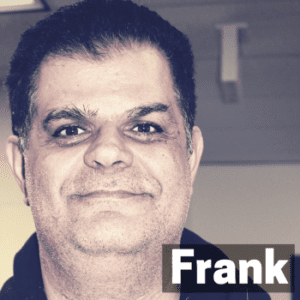“You’re not going to be able to do everything you did before, but there’s a lot of things you can do.”
In 1986, while at work, Frank fell 20 feet and fractured both sides of his skull, leaving him in a coma for three weeks. Doctors had little hope he’d recover. But as he regained consciousness, Frank began to heal at a remarkable rate. By the time he was discharged, when walking alone would have been an accomplishment, Frank could literally run out of the hospital.
“You don’t hurt yourself as bad as I did and get up and walk away,” Frank said. “You don’t hurt yourself that bad and then all of a sudden wake up out your coma and then within weeks you are walking and running.”
Despite the pace of his recovery, Frank was unsatisfied with the results he was getting from traditional rehab. Always a strong athlete, Frank wanted to be able to run as well as he had before his injury.
As the years passed, word about Frank’s recovery and athletic abilities spread, and he was asked to join the Paralympic track team at Variety Village. It took some convincing, but Frank eventually agreed to join. It wasn’t his goal to make to the Paralympics, he says, he just wanted to get stronger. Soon, Frank was training seven days a week.
“I was just [training] as therapy, and I was getting stronger and stronger, “ Frank said.
Even though the Paralympics wasn’t his goal, Frank made to Barcelona, Spain, in 1992, and returned home with gold medals in the 100, 200 and 400 meters in his discipline. He broke world records in the 200 and 400 meters, and the Canadian record in the 100 meters. Frank attributes the wins to a philosophy of giving everything you’ve got, right from the beginning.
“I just concentrate on what I’m doing and I go as fast and as hard as I can from the start,” Frank said.
23 years later, Frank stays busy. He competed more in elite-level sports, coming in fourth in the 1996 Paralympics in shot put. For a while, he worked at the Hockey Hall of Fame. Today, he’s an uber-volunteer, he says, because “I have the time.”
“Together as a group we can do things,” Frank said. “[After a brain injury] you’re not going to be able to do everything you did before, but there’s a lot of things you can do. If you get four or five people together you can do great things. Together as one we will overcome.”
As an example, Frank gathers hockey sticks, which get autographed by current and retired NHL players, contacts he made at the Hockey Hall of Fame. He then distributes the sticks to charities, which get auctioned as fundraiser items. He referees and keeps score for charity hockey games. At the Brain Injury Society of Toronto (BIST), he’s known to make a mean urn of coffee, organize indoor golf games at community meetings and basically help out with just about anything – even if it means heading out bright and early in the morning to a TTC station to talk about brain injury awareness.
Frank’s awards include the 1990 Ontario Disabled Athlete of the Year, the King Clancy Award, and an induction to the Durham College Sports Hall of Fame.





